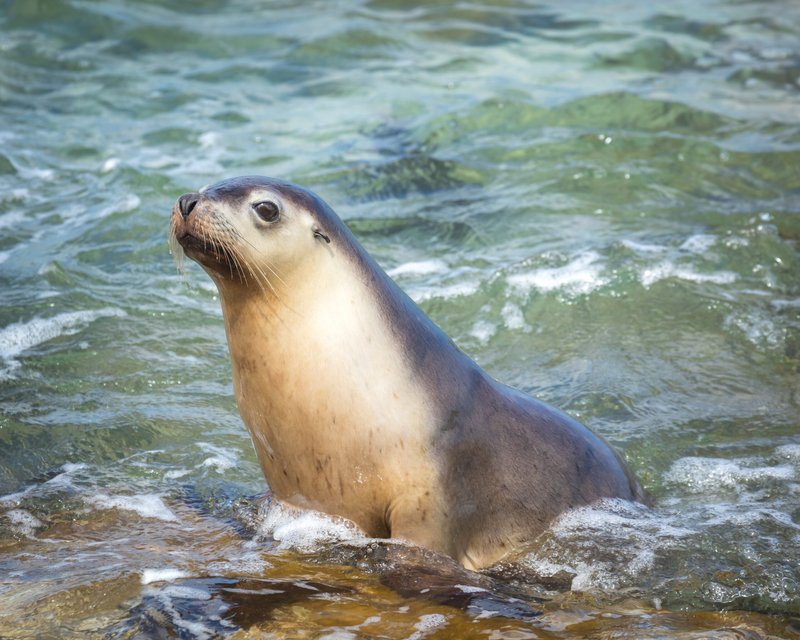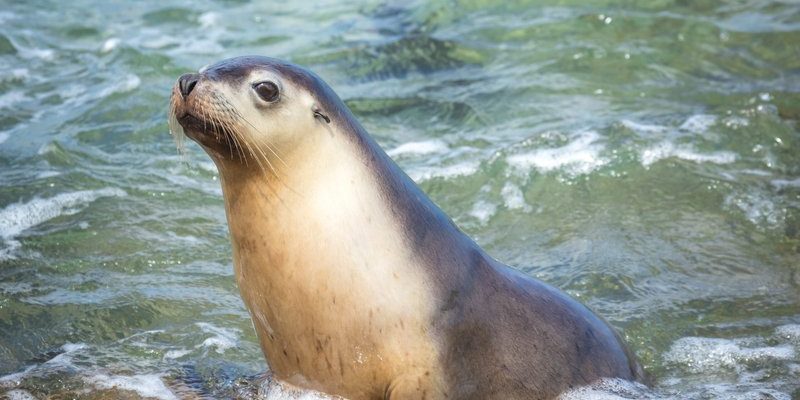
The Australian Sea Lion is one of the cutest marine animals you could ever hope to encounter. These playful creatures, with their sleek bodies and expressive faces, can often be found basking on the sandy shores of Australia. Imagine a puppy on a beach, lounging in the sun, rolling around, and occasionally diving into the water to play. That’s pretty much what an Australian Sea Lion is like! They are often described as social and curious, making them fascinating subjects for wildlife enthusiasts and casual beach-goers alike.
You might be wondering where you can find these delightful animals. Well, they call the southern and southwestern coasts of Australia their home. They enjoy sandy beaches, rocky shores, and nearby sea grass beds where they can hunt for food. Watching them frolic in the waves is not just a visual treat; it’s also a glimpse into their unique behaviors and adaptations.
In the following sections, we’ll dive deeper into everything you need to know about the Australian Sea Lion—their characteristics, habitat, diet, and even their social structures. So grab your favorite drink, and let’s explore this amazing animal!
Physical Characteristics
The Australian Sea Lion is a medium-sized pinniped, which means it’s part of the group that includes seals and sea lions. Adults typically weigh between 100 to 300 pounds, with males being significantly larger than females. You can easily spot a male by its impressive mane, which becomes more pronounced as they mature. They can grow up to around 8.5 feet in length! What’s really interesting is their coloration—these sea lions have a thick layer of fur that ranges from light tan to dark brown. And as they age, their fur often lightens considerably.
If you’ve ever seen a dog shake off water, you’d know how smoothly they move. Australian Sea Lions are just as graceful in the water. Their streamlined bodies and powerful flippers allow them to reach speeds of up to 25 miles per hour when swimming. It’s like watching an athlete glide through the water with ease. This speed comes in handy when they’re hunting for food or escaping predators.
In terms of eyesight, they are adapted for both land and underwater. They can see well in dim lighting, which is crucial for hunting during twilight hours. But that’s not all! Their whiskers are super sensitive, helping them detect movements in the water around them, making it easier to find fish and squid, their favorite meals.
Habitat
Australian Sea Lions thrive in coastal environments along Australia’s southern and southwestern seaboard. This includes places like the Abrolhos Islands, Seal Bay on Kangaroo Island, and various other secluded beaches. They prefer sandy beaches and rocky shores where they can haul themselves out of the water to rest, sunbathe, and socialize.
What’s fascinating about their habitat is the proximity to rich feeding grounds. These sea lions often forage in waters that are around 30 to 150 feet deep, but they can dive much deeper when necessary. They usually hunt in areas with abundant sea grasses and fish, making it a perfect buffet for their dining pleasure. The beauty of the Australian coast provides not just a home but also a bountiful source of sustenance.
However, their habitat is not without challenges. Human activities, like fishing and coastal development, can disrupt their environments. Conservation efforts are crucial to ensure that these playful marine mammals have safe and healthy environments where they can thrive.
Diet
The diet of the Australian Sea Lion is primarily made up of fish, squid, and crustaceans. They are skilled hunters, using their speed and agility to catch their prey either by diving to great depths or by foraging in shallower waters. On average, an adult sea lion can eat around 10% of its body weight in food each day—imagine your favorite meal being served every day, but in enormous quantities!
When hunting, they often dive for around 5 to 10 minutes, but they can hold their breath for up to 20 minutes if necessary. Isn’t that impressive? They use their sensitive whiskers to detect vibrations and movements in the water, enabling them to track down unsuspecting fish schools. This makes them highly efficient hunters, perfectly adapted to their marine lifestyle.
Interestingly, they have a unique hunting strategy called “bait balling.” During this process, they collaborate with other sea lions to herd fish into tight groups, making it easier for everyone to feast. This kind of teamwork not only showcases their intelligence but also strengthens social bonds within their groups.
Social Structure
Australian Sea Lions are known for their social nature. They often gather in large groups on beaches to rest, socialize, and breed. These groups can range from a few individuals to hundreds! Within these groups, a hierarchical structure often emerges, particularly among males. Dominant males establish territories and breed with multiple females, while younger males may try to establish their presence through displays of strength.
During the breeding season, which occurs from May to December, you’ll find fierce competition among males as they vie for the attention of females. Although it sounds rough, it’s quite a spectacle—males will engage in bellowing contests and even physical confrontations to assert dominance. However, the winners are not always the biggest; sometimes, the most strategic and clever males can secure breeding rights as well.
Females are typically more nurturing than competitive. They give birth to a single pup after a gestation period of about 11 months. New mothers are very protective of their young and often engage in vocalizations to communicate with their pups. It’s heartwarming to observe how these mothers care for their pups, teaching them essential skills for survival in the wild.
Conservation Status
While the Australian Sea Lion has a significant population, they face threats that jeopardize their survival. Some of the primary concerns include habitat destruction, entanglement in fishing nets, and competition for food with commercial fisheries. As their habitats become altered due to coastal development, their natural breeding grounds and foraging areas are affected, directly impacting their populations.
In Australia, the species is protected under both state and federal laws. Conservation efforts are in place to monitor populations and mitigate threats. Organizations work tirelessly to educate the public about the importance of preserving these unique sea lions and their habitats. Engaging with local communities to promote responsible fishing practices and habitat preservation helps create a positive impact.
Additionally, research programs focused on understanding their behavior and ecology are crucial for developing effective conservation plans. The more we learn about the Australian Sea Lion, the better we can protect it for future generations to enjoy. It’s like planting a seed today for a beautiful tree tomorrow—essential for our oceans’ biodiversity and health.
Interesting Facts
| Scientific Name: | Neophoca cinerea |
| Length: | 5.5 to 8.5 feet |
| Weight: | 100 to 300 pounds |
| Lifespan: | Up to 20 years in the wild |
| Diet: | Fish, squid, and crustaceans |
| Habitat: | Sandy beaches and rocky shores of southern Australia |
| Breeding Season: | May to December |
FAQ
What is the lifespan of an Australian Sea Lion?
Australian Sea Lions can live up to 20 years in the wild. However, their lifespan can be affected by various factors, such as environmental conditions, food availability, and threats from predators or human activities. In general, the better the conditions in their habitat, the longer they tend to thrive.
How do Australian Sea Lions communicate?
These sea lions are quite vocal! They use a variety of sounds, including barks, growls, and snorts, to communicate with each other. Vocalizations are particularly important during the breeding season when males engage in loud bellowing to attract females. Additionally, they may use body language and playful behaviors to signal to each other, especially among mothers and their pups.
Are Australian Sea Lions social animals?
Absolutely! Australian Sea Lions are known for their social nature and can often be seen lounging together in large groups. Their social structures are complex, especially during breeding seasons when males compete for dominance. This social interaction not only strengthens their bonds but is also vital for teaching young pups essential survival and social skills.
What do Australian Sea Lions do when they’re not hunting?
When they’re not hunting for food, Australian Sea Lions spend a lot of time lounging on beaches, sunbathing, and socializing with other sea lions. You might catch them playing in the surf or engaging in playful behaviors like chasing each other. This downtime is crucial for recovery and maintaining social bonds within the group.
How deep can Australian Sea Lions dive?
Australian Sea Lions are impressive divers. They typically dive to depths of around 30 to 150 feet but can dive much deeper if necessary, sometimes reaching depths of over 600 feet! Their ability to hold their breath for up to 20 minutes allows them to effectively hunt for prey in these deeper waters.
Are Australian Sea Lions endangered?
While Australian Sea Lions are not currently classified as endangered, they do face several challenges that threaten their populations. Conservation efforts are in place to protect their habitats and ensure their survival, and it’s crucial that we all work together to support these efforts. By raising awareness, we can help create a brighter future for these amazing marine mammals.
Can I see Australian Sea Lions in the wild?
Yes! You can often spot Australian Sea Lions along the southern coast of Australia, especially around places like Seal Bay on Kangaroo Island. Guided tours are available in many areas, offering a chance to learn more about their natural behaviors and habitats while observing them in a responsible manner. Just remember to respect their space and keep a safe distance!
Do Australian Sea Lions have natural predators?
Yes, they do have natural predators. Great white sharks and orcas are known to prey on Australian Sea Lions, particularly younger individuals. However, adult sea lions are usually too large for most predators to tackle. Their main defenses are their agility in the water and their ability to recognize potential threats.
What is the breeding process like for Australian Sea Lions?
During the breeding season, which generally occurs from May to December, males establish territories and call in females through vocalizations. After mating, females give birth to a single pup after about 11 months. They are very nurturing, providing care and guidance to their pups, teaching them essential skills for survival.
How do Australian Sea Lions affect their ecosystem?
Australian Sea Lions play a vital role in their marine ecosystem. As apex predators, they help maintain the balance of marine life by controlling fish populations. Additionally, their feeding habits can encourage the growth of seagrasses, which benefit other marine species. Healthy sea lion populations contribute to the overall biodiversity and health of their environment.
What should I do if I encounter an Australian Sea Lion?
If you come across an Australian Sea Lion in the wild, it’s important to observe from a distance. These animals are protected by law, so keeping a respectful distance is crucial for their safety and yours. Avoid approaching or provoking them, as they are wild animals. Enjoy the experience and take in the beauty of nature!

